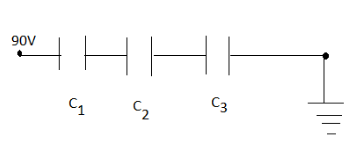Answer
402.3k+ views
Hint: Capacitors are the electronic component which stores energy. It has the ability to store energy in the form of an electrical charge across the terminals producing the potential difference. When the capacitors are connected one after the other, such an arrangement is known as the capacitors are in series and its capacitance can be found by adding the reciprocals of all the given capacitors in the series.
Complete step by step answer:

Given that- the three capacitors are connected with each other in the series as shown in the above figure.
Now, Equivalence of the capacitors is –
\[\Rightarrow\dfrac{1}{{{C_{eq}}}} = \dfrac{1}{{{C_1}}} + \dfrac{1}{{{C_2}}} + \dfrac{1}{{{C_3}}}\]
Since the given values of all the three capacitors are in the same system of units, so place the values directly in the above equation-
\[\Rightarrow\dfrac{1}{{{C_{eq}}}} = \dfrac{1}{{20}} + \dfrac{1}{{30}} + \dfrac{1}{{15}}\]
Simplify the above equation – Take LCM (Least Common Multiple)
\[\
\Rightarrow \dfrac{1}{{{C_{eq}}}} = \dfrac{3}{{60}} + \dfrac{2}{{60}} + \dfrac{4}{{60}} \\
\Rightarrow \dfrac{1}{{{C_{eq}}}} = \dfrac{9}{{60}} \\
\Rightarrow \dfrac{1}{{{C_{eq}}}} = \dfrac{3}{{20}} \\
\Rightarrow {C_{eq}} = \dfrac{{20}}{3}\mu F \\
\ \]
Now, given that potential at ${C_1} = 90V$ and ${C_3}$ being earthed, $V = 0$
Therefore, the charge $q = {C_{eq}} \times V$
Place values in the above equation – Here convert microfarad into Farad and then place it.
\[\
\Rightarrow q = \dfrac{{20}}{3} \times {10^{ - 6}} \times 90 \\
\Rightarrow q = 600 \times {10^{ - 6}} \\
\Rightarrow q = 600 \times {10^{ - 4}}c \\
\ \]
Therefore we have the charge across all the three capacitors.
Now, potential difference across the ${C_2}$ is –
$\Rightarrow {V_2} = \dfrac{q}{{{C_2}}}$
Place the values in the above equations and simplify –
$\Rightarrow {V_2} = \dfrac{{6 \times {{10}^{ - 4}}}}{{30 \times {{10}^{ - 6}}}}$
When the exponent has the same base and in the form of division, the powers are subtracted. Here the power in the denominator is negative; therefore the negative into negative becomes positive.
$
\Rightarrow {V_2} = \dfrac{{6 \times {{10}^{ - 4 + 6}}}}{{30}} \\
\Rightarrow {V_2} = \dfrac{{6 \times 100}}{{30}} \\
\Rightarrow {V_2} = 20V \\
$
Hence, the required answer - The potential difference between the plates of ${C_2}$ and the three capacitors being connected in series is $90V$.
Note: Always check the given units for all the terms when you substitute its value for the simplification. Always double check the units, and accordingly convert all the values in the same system of units. Remember basic conversational relations for the substitution. Like meter and centimeter relation and like that many more.
Complete step by step answer:

Given that- the three capacitors are connected with each other in the series as shown in the above figure.
Now, Equivalence of the capacitors is –
\[\Rightarrow\dfrac{1}{{{C_{eq}}}} = \dfrac{1}{{{C_1}}} + \dfrac{1}{{{C_2}}} + \dfrac{1}{{{C_3}}}\]
Since the given values of all the three capacitors are in the same system of units, so place the values directly in the above equation-
\[\Rightarrow\dfrac{1}{{{C_{eq}}}} = \dfrac{1}{{20}} + \dfrac{1}{{30}} + \dfrac{1}{{15}}\]
Simplify the above equation – Take LCM (Least Common Multiple)
\[\
\Rightarrow \dfrac{1}{{{C_{eq}}}} = \dfrac{3}{{60}} + \dfrac{2}{{60}} + \dfrac{4}{{60}} \\
\Rightarrow \dfrac{1}{{{C_{eq}}}} = \dfrac{9}{{60}} \\
\Rightarrow \dfrac{1}{{{C_{eq}}}} = \dfrac{3}{{20}} \\
\Rightarrow {C_{eq}} = \dfrac{{20}}{3}\mu F \\
\ \]
Now, given that potential at ${C_1} = 90V$ and ${C_3}$ being earthed, $V = 0$
Therefore, the charge $q = {C_{eq}} \times V$
Place values in the above equation – Here convert microfarad into Farad and then place it.
\[\
\Rightarrow q = \dfrac{{20}}{3} \times {10^{ - 6}} \times 90 \\
\Rightarrow q = 600 \times {10^{ - 6}} \\
\Rightarrow q = 600 \times {10^{ - 4}}c \\
\ \]
Therefore we have the charge across all the three capacitors.
Now, potential difference across the ${C_2}$ is –
$\Rightarrow {V_2} = \dfrac{q}{{{C_2}}}$
Place the values in the above equations and simplify –
$\Rightarrow {V_2} = \dfrac{{6 \times {{10}^{ - 4}}}}{{30 \times {{10}^{ - 6}}}}$
When the exponent has the same base and in the form of division, the powers are subtracted. Here the power in the denominator is negative; therefore the negative into negative becomes positive.
$
\Rightarrow {V_2} = \dfrac{{6 \times {{10}^{ - 4 + 6}}}}{{30}} \\
\Rightarrow {V_2} = \dfrac{{6 \times 100}}{{30}} \\
\Rightarrow {V_2} = 20V \\
$
Hence, the required answer - The potential difference between the plates of ${C_2}$ and the three capacitors being connected in series is $90V$.
Note: Always check the given units for all the terms when you substitute its value for the simplification. Always double check the units, and accordingly convert all the values in the same system of units. Remember basic conversational relations for the substitution. Like meter and centimeter relation and like that many more.
Recently Updated Pages
Draw a labelled diagram of DC motor class 10 physics CBSE

A rod flies with constant velocity past a mark which class 10 physics CBSE

Why are spaceships provided with heat shields class 10 physics CBSE

What is reflection Write the laws of reflection class 10 physics CBSE

What is the magnetic energy density in terms of standard class 10 physics CBSE

Write any two differences between a binocular and a class 10 physics CBSE

Trending doubts
Difference Between Plant Cell and Animal Cell

Give 10 examples for herbs , shrubs , climbers , creepers

Difference between Prokaryotic cell and Eukaryotic class 11 biology CBSE

Fill the blanks with the suitable prepositions 1 The class 9 english CBSE

Name 10 Living and Non living things class 9 biology CBSE

Change the following sentences into negative and interrogative class 10 english CBSE

Write a letter to the principal requesting him to grant class 10 english CBSE

Select the word that is correctly spelled a Twelveth class 10 english CBSE

Fill the blanks with proper collective nouns 1 A of class 10 english CBSE



